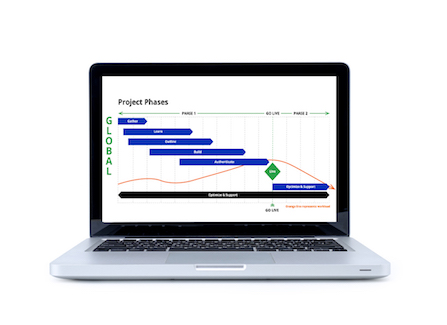Eight Tips for Getting ERP Right the First Time
Done right, enterprise resource planning (ERP) identifies and systematically eliminates activities that eat into profits. Here’s how to select a program and partner that will facilitate rather than frustrate the process.
Posted: November 18, 2020
DIGITAL BY DESIGN COLUMN
BY DUSTY ALEXANDER
With pressure to increase productivity and improve quality constantly increasing, you may have considered rolling out an enterprise resource planning (ERP) program to cut costs and boost productivity. But something keeps you from pulling the trigger.
There’s never a perfect time for a major capital investment, especially if it will require organization-wide change. When business is slow, the idea of spending money is unappealing. When business is growing, employees feel they’re too busy to take on something new. ERP can be especially daunting because of the time and effort required to find a platform appropriate for a company’s unique needs. However, manufacturers in all industries have used the tool for roughly five decades. Ignoring its existence, particularly as technology improves, risks losing ground to competitors that have taken the plunge.
Developed in the 1970s, ERP software started out as a few unrelated programs slapped together to improve various parts of the manufacturing process. The best software evolved into highly comprehensive, fully integrated platforms that enable companies to manage the entire manufacturing process from a central location while streamlining operations in ways that weren’t previously possible.
Whether housed in-network at a manufacturing facility or in the cloud, the software brings all information, from quote to cash, into a single, easily accessible database. Benefits include fewer errors, faster production, and a better bottom line. In addition, the software provides financial data in real time, instead of at the end of the month or quarter, so managers can make better decisions for the long term. When properly implemented, the software empowers the entire organization to become leaner, more efficient and, ultimately, more profitable.
But not all programs are created equal. Here are eight tips for ensuring your investment meets your company’s needs now and in the future.
Form a Cross-functional ERP Team
Contrary to popular opinion, selecting the software shouldn’t be left solely to IT. In fact, you’ll almost certainly fail if you do. That’s because IT’s expertise is in networking and hardware issues, not operations, purchasing, accounting, scheduling, etc.
Think of ERP as a business philosophy more than a software program. It’s an interrelated tool that touches every aspect of the business. As such, identifying the program that’s appropriate for your company’s unique needs requires the input of everyone who will use it, from shop floor employees to managers to stakeholders.
Have the team conduct a needs analysis to develop a matrix of capabilities the program must have and what would be nice but not absolutely necessary. The matrix doesn’t have to be complicated, but it does require asking all stakeholders what their greatest pain points are. Identify them department by department, asking what activities consume the most time and effort.
The team should use this information to set specific goals the software will be expected to deliver. For example, “improve on-time delivery by at least 50%” will yield better results than “improve on-time delivery.”
The team also will work with the software vendor to develop and execute an implementation plan (more about that later).
Provide Full Management Support
ERP involves change, which is never easy. If you and your management team aren’t fully committed to confronting and working through challenges, you won’t get the necessary employee buy-in.
Ideally, assign an ERP “enforcer” who knows how to work the company culture to get things done. In small companies, that might be the owner. Larger companies should assign someone everyone knows has the CEO’s support. Then, give them full authority for overseeing the effort.
Set the Stage for Full Employee Buy-In
Whether they want change or not, most employees understand that remaining competitive requires deploying new technology – including software. If they’re asked for their input on what features will make their jobs easier, they’ll be predisposed to facilitating implementation.
To help them, hold them accountable for learning and using the system. If you don’t, and legacy systems are still accessible, employees will revert to what they’re comfortable with – and you’ll have wasted your financial investment as well as a lot of people’s time and effort.
Identify A Short List of Candidates
With so many software programs out there, identifying the right one can be daunting. Given the cost, integration requirements, and potential long-term impact, everyone on the team should understand the evaluation process requires time and effort.
You want a system that integrates all aspects of running a manufacturing business, is easily customizable, adapts to how you do business rather than the other way around, is designed from the ground up as ERP rather than cobbled together from different software programs, user-friendly (spend time moving through the system’s various screens), and – perhaps most importantly – fully integrated, meaning a change made in part of the system is automatically made systemwide.
One final tip: Look for software that’s strongest where you’re weakest. For example, if scheduling’s the biggest bottleneck, seek a program with a particularly robust scheduling module.
Once the team identifies three to five candidates, bring each one in to show why their software best fits your company’s needs. Do them do a test run of how the system flows as well as a canned demonstration of features and benefits.
Investigate Your Short List
In addition to buying software, you’re starting a relationship with a partner that will impact your company’s future success. You want a vendor whose culture and values are similar to your company’s and that will be there for years to come.
How long has the company been in business? Has it been bought and sold multiple times? How many successful implementations has it had? Were they with companies similar to yours?
What about the people your team will be working with? Use LinkedIn to find out their background: how long they’ve been with the vendor, where their expertise lies, and whether they’ve worked in manufacturing in addition to software development.
Ask for references and ask each one these key questions: Would you choose this vendor again? Why or why not?
Choose One of Two Implementation Methods
A phased-in approach implements the software one or two modules at a time beginning with areas that need the most improvement. It gives employees time to learn the software before going live and provides opportunities for quick wins, but can open the door to procrastination.
With the big-bang approach, all employees train at the same time and all data is converted all at once. Having everyone in the same boat drives cohesion, but requires more intensive training to ensure employees are ready to use all features when the system goes live.
Choosing an approach depends on your time frame and how much employee resources your company can afford to commit to the project. A good vendor will make a recommendation based on their understanding of your company’s needs, but the final decision rests with your implementation team.
Write an Implementation Plan
Regardless of method, implementation involves four steps: preparation, converting data, training/testing, and going live. Each step should have completion deadlines and assign individuals and/or departments responsibility for ensuring deadlines are met.
A good vendor will insist on a plan and work with you to create one. It can be done in a one- or two-page spreadsheet. It should include technical issues IT will have to deal with, goals and objectives, assign tasks to individual employees and departments, and set deadlines for milestones such as the go-live date.
The best vendors provide an audit form that tracks progress against the plan. Don’t freak out if the timeline must be tweaked to accommodate unforeseen issues. For example, you may have trouble scheduling implementation and training around work demands. The goal is to follow the steps, in order, from start to finish.
Maximize Success with Adequate Training
You can never have too much training, nor does training end when the system goes live. Some manufacturers bring in vendor instructors every year to answer questions that help employees optimize the program.
In general, the more employees a company has, the less training costs. If you employ 15 or more people, a training budget of 25% of the software’s cost is a realistic minimum.
The best vendors offer three types of training: vendor-based, where employees spend three to five days at the vendor’s site; on-site, where the vendor comes to your facility for one or more days to work with your company’s actual data; and online, with one-to-two-hour canned tutorials and live subscription classes led by an instructor.







